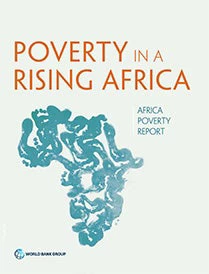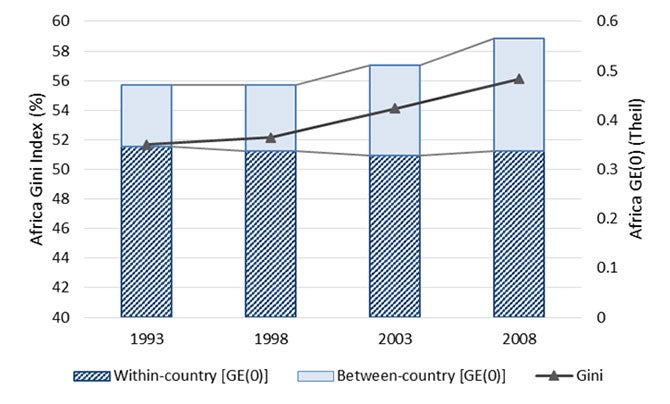
This also leave the question whether the conclusions would change when we ignore national boundaries and look at inequality among all African citizens instead. Doing so puts the disparities that exist within African countries into context with the disparities that exist within the region as a whole, akin to the interpersonal global income distribution. Such a perspective on inequality comes naturally to an international organization as the World Bank.
One might also be interested in regional interpersonal inequality, if extreme levels contribute to issues such as migration flows. In a nutshell, we are interested, for a person living in Africa, how much of her position relative to other Africans is determined by the country she happens to be living in, vis-à-vis the position relative to her fellow country citizens?
This is the approach La-Bhus Fah Jirasavetakul and I take in a recently-released background paper to the poverty report. We put all Africans on the same scale of consumption expenditure, regardless of their country of residence, and study the evolution of inequality among all Africans. We use only data from household surveys, which cover around 70% of the regional population. The coverage of countries is changing over time. Here we present the results on the cross-sectional sample of countries while our results of increasing regional inequality is robust to using the balanced sample.
Average consumption in Africa as a whole (as measured from household surveys) increased by approximately 15% (or 0.92% per annum) between 1993 and 2008 but this growth was distributed unevenly. As a result interpersonal African inequality increased between 1993 and 2008. As noted above, it is possible that these results are a lower bound given that the surveys are likely to underestimate consumption at the top of the distribution (see here for a regional analysis of the super-wealthy) and given that the coverage of fragile countries remains low.
The Africa-wide Gini increased from 52% to 56% (see the green line in Figure 1). Together with the lack of a systematic increase of within-country inequality in the region, this implies that the rise in regional inequality was driven by increasing inequality between countries, i.e. an increasing dispersion in average consumption across countries. Indeed we find that share of Africa-wide inequality which is due to differences between countries increased from 27% to 40%. The bars in Figure 1 decompose the overall level of African inequality into differences within and between countries – it is clear that the within-country component has remained broadly unchanged (or declined very slightly), while the increase in overall regional inequality was driven by increasing dispersion between countries.

These figures reflect only relative gains while absolute disparities have increased even more. The dispersion of absolute gains was such that almost 40% of the total gain in consumption between 1993 and 2008 went to the top 5% of the African distribution.
The findings contrast starkly with the East Asian experience. In the early 1990s, average consumption per capita was comparable in the two regions or even slightly lower in East Asia. However, growth has been much faster in East Asia since then: Between 1992 and 2007, average consumption (from household surveys) in Asia increased by 6% per annum, with the poorest part of the distribution growing at 4% per annum. While regional inequality also increased in East Asia, the (already modest) growth in Africa is distributed even more unequally. In fact, Africa has the highest level of regional inequality compared to other regions of the world (see here).
Our regional perspective has provided a view of interpersonal inequality that is complementary to the typical within-country analyses. We show that the inequality amongst all Africans has increased. This has been driven by increasing differences between countries while within-country inequality has remained roughly unchanged. We would like to end on a cautionary note: Our data finish in 2008, so it would be important to update this work for the more recent periods. But maybe most importantly, we need to get better data to capture the top end of the distribution which matters both for studies of within-country and regional inequality.
This blog is part of a series reflecting on the findings of the 2016 World Bank Report “Poverty in a Rising Africa." Next in the series: intergenerational mobility in Sub-Saharan Africa on Feb. 15, 2016. Previous blogs in the series include:
- Africa is rising! But are people better off?
- Who will fund poverty surveys in Volkswagen countries?
- The European refugee crisis: What we can learn from refugees in Sub-Saharan Africa
- Poverty is falling faster for female-headed households in Africa
- The shock of widowhood: Marital status and poverty within Africa
- Domestic Violence and Poverty in Africa: When a Husband’s Beating Stick is Like Butter
- Data gaps: The poor typical household survey’s miss
- Inequality of opportunity in Sub-Saharan Africa


Join the Conversation